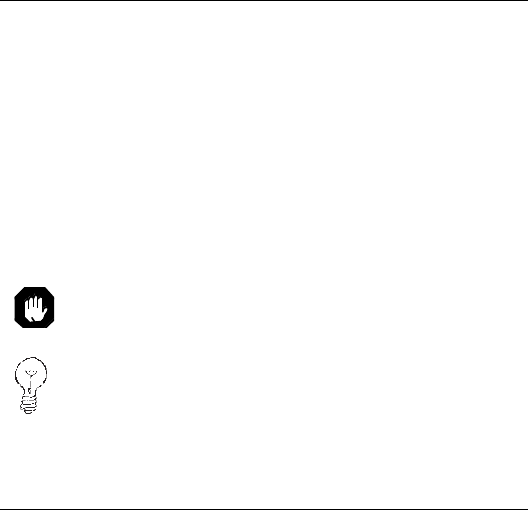
Magellan NAV 6500/NAV 65102
Conventions Used in this Manual
The reference section of this manual is designed to assist you
in the use of your receiver. Each topic in the reference section
includes a brief description of the activity chosen, a pictorial
view of the keys to press, and a detailed description with sample
screens of how to perform the activity. As you become more
familiar with your receiver, you will be able to use the picto-
rial view of the keys as a "quick reference" to perform the
desired activity.
Also in the reference section are alerts to inform you of some
cautions or notes that will assist you in using your receiver.
The stop sign indicates information that is very
important and should be read before continuing.
The light bulb denotes information that can help
you use or understand your receiver. While this
information is not required to perform the activity,
it may provide you with a better understanding of
the activity or shortcuts you can use.
Commonly Used Terms
A few of the terms used in this manual may be unfamiliar to
you and are described in the Glossary found in the Appendix.
To help you get started, some of the more common terms are
described here with a simple explanation as to their meaning.
Position Fix: The receiver attains information from GPS satel-
lites to compute a value (coordinates) that describes your
unique position on the earth. This is called taking a posi-
tion fix and the coordinates computed are referred to as the
position fix.
Waypoint: (Abbreviated as WPT.) A position fix can be saved
in memory with a name and type that you either assign or
let the receiver assign for you. These saved position fixes are
called waypoints.
MARK: You can mark the cursor position or your present po-
sition at any time by pressing the MARK key to create a
waypoint.
GOTO: You can actually "Go To" a saved waypoint or any
cursor position simply by pressing the GOTO key and choos-
ing a destination waypoint. The receiver will navigate you
from your present position to the waypoint chosen with
bearing and distance information.
Route: A route is slightly different from a GOTO. A route
contains a starting and ending waypoint and may include
intermediate waypoints along the way. Routes can be from
one waypoint to another (a single-leg route) or from a
waypoint to a series of waypoints, (a multi-leg route) up to
50 legs.
Leg: Legs are the divisions of a route between waypoints. A
route that goes from WPT A to WPT B, from WPT B to
WPT C, and from WPT C to WPT D has three legs.


















